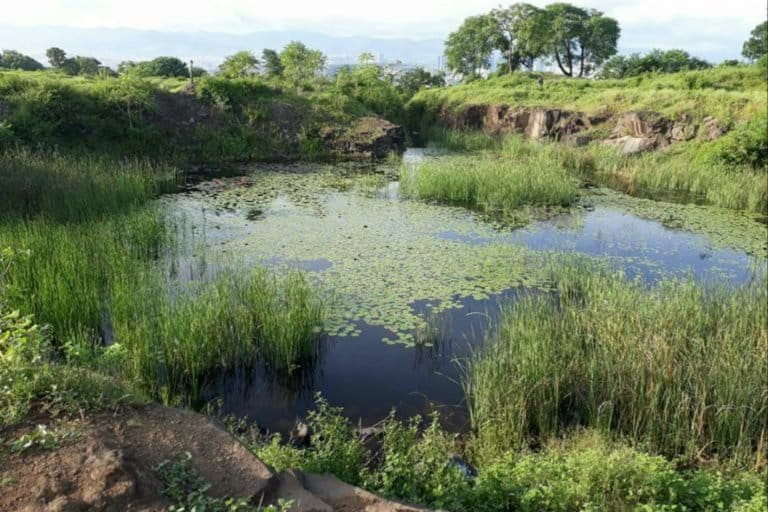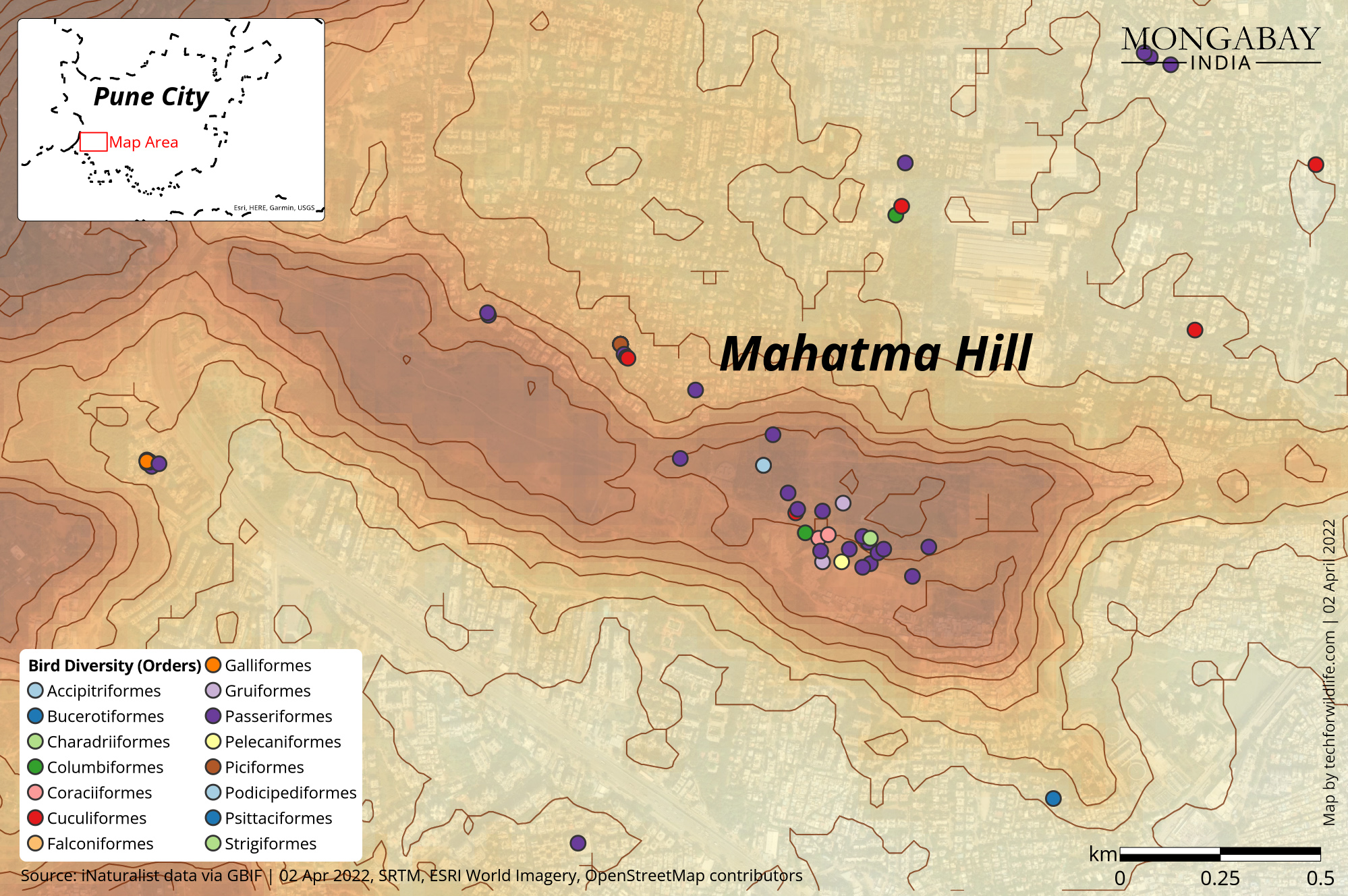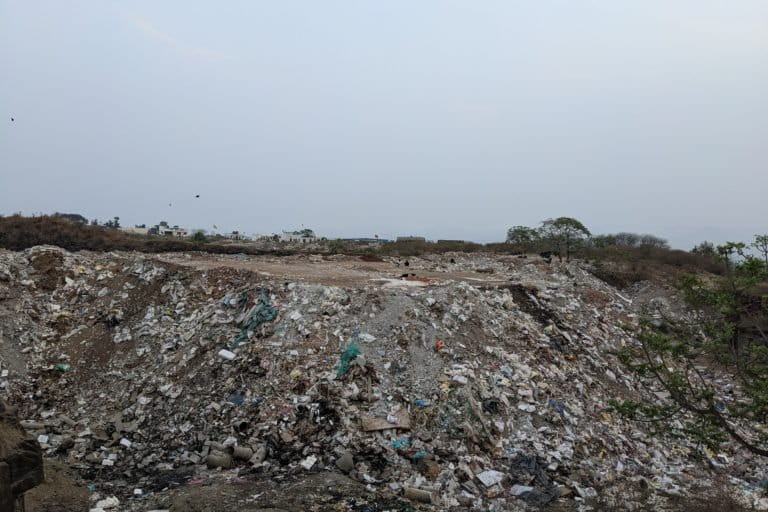- Pune’s Mahatma hill, an offshoot of the Western Ghats, is home to around 129 species of resident and migratory birds, according to a checklist created by three young students over seven years.
- Several species that are listed as “common birds showing strong long-term decline” in the State of India’s Birds, 2020 report are found on Mahatma Hill. Some of these birds have been spotted only once in the past five years.
- In the past two years, Mahatma hill is being used as a garbage and debris dumping site. Encroachment on the hill and increased anthropogenic interference in the hill’s ecosystem are affecting the avian habitats here.
- Conservation of small patches of urban biodiversity such as Mahatma hill is also important to regulate the microclimate of cities.
In June 2020, 20-year-old Arnav Gandhe was on a birding visit to Pune’s Mahatma hill, an offshoot of the biodiverse Western Ghats. He was about to wrap up for the day when he spotted a flock of 50-60 kites in the sky. On closer examination, he noticed that one of the birds was of a different colour, which sparked his curiosity. “From the body structure and flying pattern, I recognised this to be a short-toed snake eagle, which I had never spotted in this area before. It was even more special to see a single short-toed snake eagle, which is usually a solitary bird, flying with kites,” shared Gandhe.
This was Gandhe’s sixth year of documenting the avian diversity on Mahatma hill, a four-kilometre stretch of grasslands and woodlands near his home. He started visiting the hill when he was in eighth grade, at the age of 13 and observing the biodiversity there. Within the first few months, he realised that this landlocked hill was replete with biodiversity and decided to start photographic documentation of the bird species here. He then found two more birders Atharv Bapat and Adwait Dindore, who had also been observing avian diversity here, and decided to collaborate with them. Pooling data with a few other regular hill visitors and bird photographers, the trio documented 129 resident and migratory bird species and prepared a checklist of the birds of Mahatma hill.
Their documentation, published in the popular birding periodical Newsletter for Birdwatchers, is the first known documentation of the biodiversity of Mahatma hill. Of the birds that inhabit this hill, 114 were observed between 2016 and 2021 while 15 other species have been rarely spotted in the recent past, indicating that some species may perhaps be vanishing from this area. For example, the Indian eagle owl, little blue kingfisher, crested serpent eagle, and white-eyed buzzard have been rarely spotted or spotted only once in the past five years.

A small but important hill
Mahatma hill, (or Mahatma tekdi, as it is called in Marathi) in Pune’s Kothrud area, is behind Mahatma Housing Society, after which it is named. This hill was connected to the adjacent hills which are offshoots of the Western Ghats until the NH-48 highway was constructed in the 1990s. “Such fragmentation of habitats does not affect most birds because they can fly and occupy any patches that can serve as a habitat. Birds need vegetation, and if there is enough vegetation, birds can survive. Unfortunately, development changes the habitat and reduces the spaces they can occupy,” shared Swati Gole, director of Pune’s Ecological Society.
Pune lies in the Western Ghats, and the city is dotted by hills, locally known as tekdis. For most Puneris, visiting the tekdi for a morning or evening walk is a part of their daily routine. Pune’s famous tekdis include Vetal hill (also known as mini Sahyadri due to its rich biodiversity), Taljai hill, Sinhagad hill, and Parvati hill. These hills are known for their avifauna, butterflies, reptiles, and amphibians.
Smaller than other Pune hills, Mahatma hill comprises patches of woodlands, grasslands, a manmade plantation landscape, and stone quarries that transform into wetlands after the monsoons, one of which Gandhe has named as the “francolin quarry” because he heard the call of the francolin here every morning in the initial years of his study. This diversity of habitats creates suitable conditions for avian diversity.

The grasslands support several ground-dwelling and ground-nesting bird species, whose populations are now dwindling due to increased anthropogenic interference and development around the hill, said one of the authors of the study Atharv Bapat (22). “We observed the behaviour of the ashy-crowned sparrow-lark during its breeding season and found that being a ground-nesting species it was really difficult for this bird to mate due to the increased human interference. They are troubled not just by humans but also by feral dogs and cats. The rufous-tailed lark also faces the same problem,” shared Bapat. The data shows that the population of both these species is decreasing day by day, he added.
The presence of humans is more troublesome to mammals than birds. The black-naped hare, langurs, and barking deer were once residents of Mahatma hill but have not been spotted here in the past several years. However, scorpions and several species of reptiles such as Indian cobra, common krait, Russell’s viper, rat snake, checkered keelback, green keelback, oriental garden lizard, and the fan-throated lizard continue to live on the hill.
Adwait Dindore (19), one of the authors of the study, shared that birds that need specific habitats were finding it difficult to live on the hill. “Birds such as owls are territorial and need their own space. If they don’t get such space they disappear from the area. The hoots of the Indian eagle owl, for example, were heard in the quarry area last in 2015 and they have not been heard or spotted since then,” he shared.

Avifauna maintains functionality of hill ecosystems
Pune’s hills have always housed several species of grassland and scrubland birds but there has been an increase in woodland birds in the past three decades because open country habitats have been replaced with plantations, shared Sanjeev Nalavade, expert birder and retired professor of geography at Fergusson College, Pune. Experts have noted that plantation of exotic species has adversely affected the avian diversity of the city’s native savannah ecosystem, replacing grassland species with woodland birds.
The number of bird species in Pune has increased due to better reporting by birding enthusiasts covering a larger part of the city, and also because the city has added manmade lakes attracting more water birds. From 130 bird species listed in the March bird count in 1979 by Prakash Gole, Pune’s diverse habitats have grown to support more than 400 species in 2017. Nalavade, however, warns that the populations of some birds have seen a sharp decline, while numbers of scavengers such as kites, crows, and feral pigeons have multiplied.
The bird population of India, however, has declined significantly, according to a report titled State of India’s Birds, 2020: Range, trends and conservation status released at the 13th United Nations Conference of Parties to the Convention of Migratory Species held in 2020. Mahatma Hill is home to several species listed by this report as “common birds showing strong long-term decline”, e.g., the small minivet, common woodshrike, rufous-tailed lark, blue rock thrush, short-toed snake eagle, and red-necked falcon. The short-toed snake eagle, which this report has identified as a key species needing most conservation in Maharashtra, has been spotted only once at Mahatma hill. Sanjeev Nalavade shared that there have been a few records of it every year on the hill adjacent to Mahatma hill.

Birds such as the Indian golden oriole and Indian roller, which were once extremely common in Maharashtra and had special importance in Marathi culture for helping ancestors identify changes in seasons, are now restricted to Pune’s hills and outskirts, shared Nokesh Lele, a regular visitor of Mahatma hill and one of the contributors to the Mahatma hill avian checklist.
“In Marathi, there was a saying that once you spot the haldya bird (Indian golden oriole) making nests, you know that the Chaitra month is starting and the summer is here. The nilkanth bird (Indian roller) used to be a reminder that the Mahashivratri festival is approaching. However, now we have to visit the hills or outskirts of the city to spot these birds,” said Lele.
In recent years, and especially since the first pandemic-related lockdown in 2020, Mahatma hill has become a debris and garbage dumping site. Treating the rich savannah landscape as a wasteland is a “disservice to the grassland-habitat specialist birds and other grassland endemics like fan-throated lizards” said Ashish Nerlekar, PhD candidate at the Department of Ecology and Conservation Biology, Texas A&M University, College Station, Texas, USA over an email interview.
Swati Gole explains that the hill and its avifauna have a symbiotic relationship. “While the grassland birds require vegetation and a healthy habitat for survival, the avifauna has an important role in maintaining the functionality of the hill ecosystems. Conserving diverse habitats is thus a way to conserve birds, as well as regulate the microclimate in urban areas,” she shared. By studying the avian diversity at Mahatma hill, Arnav Gandhe says he hopes to collect data to make a case to conserve the area effectively.
“Conservation within national parks and sanctuaries is important but it is equally important to protect areas like Mahatma hill which regulate the microclimate in urban areas. Urban biodiversity and wildlife are understudied topics. We just assume that all the biodiversity is in national parks and sanctuaries, which is not true. Urban wild spaces, if conserved effectively, are equally wild, and play an important role in climate change mitigation and biodiversity conservation,” shared Gandhe.
With summer temperatures rising in Pune, many city dwellers reminisce about the old times when summers used to be pleasant. In the past decade, pleasant memories associated with summers have drifted away, with temperatures regularly crossing 40 degrees Celsius since 2012 in Pune. Pune is among the ten Indian cities where the annual mean temperature has increased significantly during the last four decades. With rapid urbanisation and land-use changes, Pune has also begun experiencing the urban heat island effect, making the conservation of urban open spaces in the city even more important.

Banner image: A small minivet at Mahatma hill in December 2021. Photo by Nokesh Lele.
